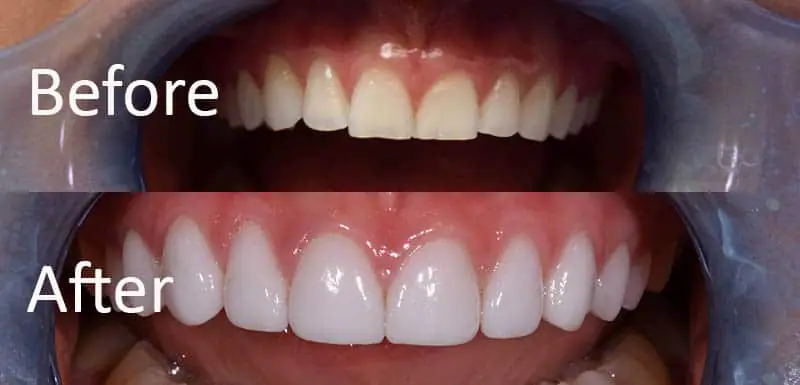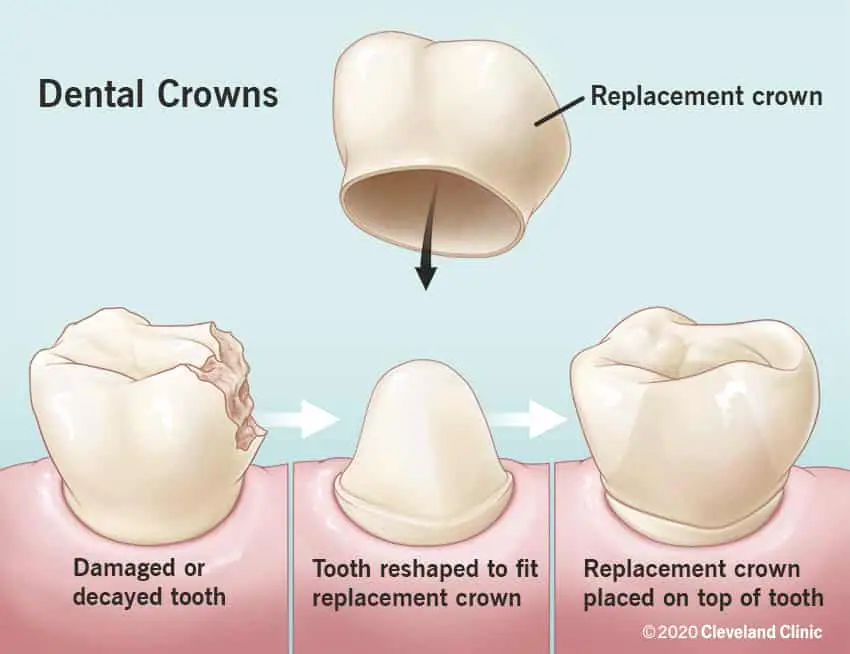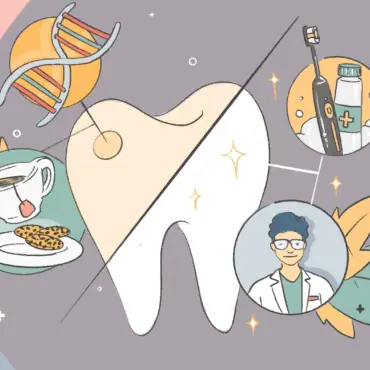Veneers or dental crowns, oh my! You have a dental issue you want to fix, but how do you know when you should choose which procedure? The easiest way is to ask your dentist’s advice. But, if you’re interested in understanding more about each procedure yourself, read on to compare veneers vs crowns and learn how to choose between the two.
What are veneers?
First, you need to clearly understand what each procedure entails. Dental veneers are thin wafers that are attached to the front of your teeth. They can be made of materials like porcelain or composite. Porcelain veneers are the most sturdy, but also the most expensive.

Image source: Spring Creek Dental
To attach the veneer, your dentist will first grind a little off the front surface of your tooth. This roughens up the tooth enamel to help the veneer bond more strongly to the tooth. It also makes space for the approximately 1 mm thick veneer to sit on the front of your tooth.
The dentist will then either digitally scan or make a mold of your teeth to have the veneers made. If your dentist has an in-office machine this can happen the same day. Otherwise, it will be sent off to the lab and you’ll come back a couple of weeks later when the veneers are ready to be cemented into place.
Veneers are considered cosmetic dentistry and are used to fix a number of cosmetic issues. For example, chipped or slightly crooked teeth. Sometimes if your teeth have experienced significant discoloration and traditional tooth whitening methods aren’t working, you can use veneers over all your front teeth to change the color of your teeth and restore your beautiful smile.
Keep in mind that because of the grinding involved to make space for the thin layer of material, veneers are not a reversible procedure. If your veneers are damaged or become discolored, the only way to fix them is to replace the veneer with a new one.
What are crowns?
When looking at porcelain crowns vs veneers you need to understand something. Veneers are considered purely cosmetic dentistry; dental crowns are considered a restorative procedure. Instead of just a thin layer on the front of the tooth, they completely encase the tooth, like a little cap over the top.
They are generally used when the natural tooth structure has been damaged by a large cavity or infection or broken by a blow to the tooth. Whereas veneers are typically only used on the front teeth, crowns can be used on any tooth and often appear on molars.
To place a crown, the dentist will typically grind down and reshape your existing tooth to make room for the crown as well as prepare the surface for bonding. Once the tooth structure is ready, your dentist will take a digital scan or make a mold to craft a custom-fitted crown. Again, this can either happen in the office or be shipped off to a lab.

Source: Cleveland Clinic
If you have to wait a couple of weeks for the permanent crown, your dentist will often place a temporary crown. This allows you to eat and speak comfortably while you’re waiting for the permanent crown to be made.
Do veneers or crowns last longer?
How long either option will last depends on a few factors, including your dentist’s expertise and how well you take care of them.
The material you choose is also a big one. Porcelain veneers can last about 10-15 years, whereas composite veneers might only last 5-7 years.
Book a dental consultation.
Find a dentist near you to tell you more about getting started on this procedure.
Crowns can be made from various materials. Gold and gold alloys have been used in dentistry going back thousands of years. Metal crowns are incredibly sturdy and can last for decades. The main disadvantage is that you obviously have a piece of metal in your mouth. These crowns are usually placed on molars.
Porcelain crowns can be made to look like natural teeth but are more fragile. These tend to be used on the front teeth for aesthetic reasons.
Porcelain crowns bonded over a metal alloy marry the two and give you the best of both worlds. Unfortunately, a thin metal line is often visible near the gum line.
How you take care of your teeth will significantly impact how long both dental procedures last. Always brush and floss daily and avoid using your teeth to cut things, especially if you have veneers on your front teeth. Plus, don’t forget to make a dentist appointment and visit them twice a year.
Are veneers or crowns more expensive?
Veneers are often referred to as the “Hollywood smile.” They are done solely for cosmetic purposes and can cost a pretty penny, particularly when you have them placed on multiple teeth.
However, veneers are smaller than crowns. They only cover the front part of the tooth whereas dental crowns cover the entire tooth.
Following that logic, you would expect the cost of veneers vs crowns to be less expensive. In general, they are. The cost per tooth for a porcelain veneer ranges between $925 and $2,500 dollars. Veneers made from composite are less expensive, ranging from $250-$1,500, but don’t expect them to last as long.
The cost per tooth for a porcelain crown ranges from $1000-$3,500. And that doesn’t include the cost of the root canal or any other dental work that precedes the crown.
However, there is a key difference you need to be aware of. Veneers are considered a purely cosmetic procedure. Thus, dental insurance generally won’t cover them.
But crowns are often used when there is a medical problem with the tooth. They may be used to hold together a cracked or broken tooth, or support and protect a tooth with a large cavity.
Because of this, dental insurance will often cover some or all of the procedure.
Book a dental consultation.
Find a dentist near you to tell you more about getting started on this procedure.
What are the pros and cons of veneers and crowns?
Veneers are a great option to beautify your teeth when there are no other dental problems present. Depending on the type of veneer, only a minimal amount of grinding is necessary, leaving more of your natural tooth structure intact.
Unfortunately, veneers will need to be replaced as they wear out. The procedure is not reversible, so once you take the plunge, you’ll have to maintain them for the rest of your life. Since they don’t cover your whole tooth, they leave your existing tooth vulnerable to tooth decay. However, proper dental hygiene can cut down on the dangers of this significantly.
Porcelain crowns look and feel just like your natural teeth. Plus, the whole tooth is covered by the cap, protecting it from tooth decay. Crowns are relatively permanent and when placed for medical reasons are usually covered by insurance.
Metal crowns are sturdy, but obvious and natural-looking porcelain is more fragile. Porcelain over metal can be a good option, but you’ll have to deal with the thin dark line at the base. Crowns also require grinding down more of your existing tooth to prepare the site. Crowned teeth can be more sensitive to hot and cold.
Questions to ask your dentist about crowns vs. veneers
Now you have a better idea of what these two procedures entail. Before you decide which procedure is right for you, be sure to discuss these questions with your dentist.
How long can I expect this dental crown to last?
Your dentist can give you a better idea of what to expect with the materials they will choose for the procedure.
Do you recommend any type of special care after the procedure?
Regular flossing and brushing will always be necessary for optimal oral health. As well as visiting a dentist near you twice a year.
Are refittings included in the price for crowns?
Crowns can move a bit after placement, throwing off your bite. They can be adjusted, but you should know if you’ll be charged more.
What other options are available?
If cost is a concern when you want to get veneers, Lumineers may be an option. This type of veneer is thinner and cheaper but doesn’t always cover dark stains or badly broken teeth.
For broken teeth, dental bonding can be a more adequate option. In this procedure, your dentist uses a special composite resin to build up the tooth and replace the missing portion.
Instead of putting a crown over a badly damaged tooth, it may make more sense to remove it and replace it with a dental implant instead.
Ready for a beautiful smile?
Regardless of which procedure you choose, rejoice that modern dentistry offers us such great options. With affordable and accessible dental care, everyone can enjoy the dazzling smile they dream of.
Ready to level up your oral health and wellness? Find a dentist and get started today!
Due for a checkup?
Find a top rated dentist near you that takes your insurance.








